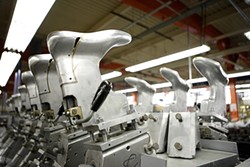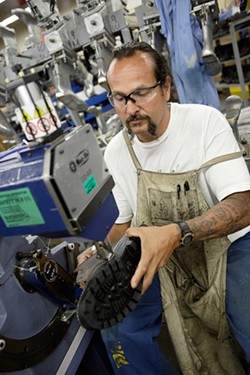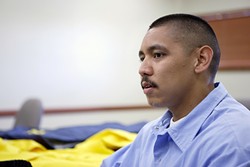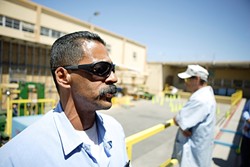In his own words, Mark Delaplane “killed a guy,” and for the last 32 years, he’s been paying for the crime. He’s gone through all the programs and certifications; he has seemingly been a model prisoner. He exudes an obvious intelligence and reads management books on corporate quality control theories for fun.
Yet when he talks about what he misses most about life outside of prison, this is what he says:
He’d like to walk into a store, buy a fresh peach, and eat it.
“We don’t get fresh fruit in here, just a few mealy apple slices.”

- PHOTO BY STEVE E. MILLER
- PUT YOUR BEST FOOT FORWARD : Silver shoe molds await another run of boots in the California Men’s Colony’s Prison Industry Authority-run shoe factory, one of three business operations staffed by inmates.
The reason? “They’re afraid we’ll make alcohol with it.”
California’s prisons are overcrowded with inmates with the sort of resourcefulness it takes to turn apples into applejack wine, but, for the most part, their industriousness rarely transcends the prison walls.
This is a story about an exception to that rule.
About three years ago, when Gov. Arnold Schwarzenegger issued an edict that state prisons must be reformed, it appeared that a seismic shift had occurred within our state prison system. Schwarzenegger changed the name of the California Department of Corrections to the California Department of Corrections and Rehabilitation (CDCR). Instead of focusing on punishment, California’s prisons would focus on rehabilitating prisoners.
For 700 or so California Men’s Colony (CMC) inmates currently involved in the Prison Industry Authority (PIA) programs, the state’s much ballyhooed promise of rehabilitation feels within reach.
These are the select few men in one of the CMC’s three PIA-managed business enterprises—a shoe factory, a knitting factory, and a printing shop—who are working at coveted jobs, which pay from 30 to 95 cents an hour. These lucky 700 are allowed to work and take classes after work hours to complete their GEDs—the equivalent of a high-school diploma. Other CMC inmates must choose between work and earning a GED. And these 700 men can also participate in certificate programs that train them vocationally, such as forklift operator or hazardous waste disposal certifications that can lead to well paying jobs on the outside.
Without question, the PIA offers the most successful rehabilitation program in the state prison system. The recidivism rate for inmates who have gone through PIA training is vastly lower than general population inmates—about 25 percent compared to 70 percent. Yet in a state system that currently houses 170,000 prisoners, only 6,900 are employed within PIA programs; for 163,100 prisoners—5,900 of them at CMC—the promise of rehabilitation is, so far, largely unfulfilled.
Adding “Rehabilitation” to the name of the state prison system doesn’t necessarily make it so.
How’d we get here?
From 1940 to about 1970, the California state prison system was considered a national model of efficiency and rehabilitation. Today, it’s a system in distress.

- PHOTO BY STEVE E. MILLER
- IDLE HANDS ARE THE DEVIL’S WORKSHOP : Inmates like Rick Corral find they stay out of trouble and their prison time goes faster when they have a job, and it’s nice to have a little money to spend at the prison canteen, too.
California spends a whopping $43,000 per year for each of its prisoners, and our state has the highest rate of overcrowding in the nation, with a prison population that exceeds 200 percent of our prisons’ design capacities. For instance, the CMC was designed to house 2,400 inmates yet currently holds 6,600. Due to the unmanageable number of inmates in the system, even AB 900—the bill signed into law about 18 months ago that’s designed to alleviate overcrowding and guide the system toward focusing on rehabilitation rather than punishment—has little hope of improving conditions for the majority of California’s inmates. There are just too many of them.
California’s system is so hopelessly mired that Schwarzenegger has declared it is in a fiscal state of emergency, and the federal courts are considering imposing a cap on our prison population, arguing that the level of overcrowding creates a condition of unconstitutional “cruel and unusual punishment.”
The reasons why state prisons are so overcrowded are many and open to debate. Some people point to the three-strikes law, which imposes a mandatory 25-years-to-life sentence in cases of a third felony conviction. Others point to mandatory sentencing laws, such as the one that adds 10 years to such crimes as robbery if a gun is used. Others claim the War on Drugs has filled prisons with drug offenders, some of them non-violent. While all three factors account for some overcrowding, experts believe the most serious problem in California stems from a dysfunctional parole system.
According to Joan Petersilia, a professor of criminology, law, and society at U.C. Irvine and the author of When Prisoners Come Home: Parole and Prisoner Reentry, the problem is that California returns more parolees to prison than any other state.
In a Los Angeles Times piece explaining her findings, Petersilia and her co-author Robert Weisberg wrote, “Of the approximately 115,000 inmates annually released, about 70 percent of them are back behind bars within 24 months—nearly twice the national average. Worse yet, about 10 percent of these prisoners will repeatedly return—six or more times over a seven-year period, according to one study. No other state reports such a high inmate-churn rate.”
Some prisoners are given parole dates by the State Parole Board, only to have Gov. Schwarzenegger (and past governors) deny them parole. Many parolees receive too little monitoring and, according to Petersilia and Weisberg, some “are released from parole too early and commit serious new crimes, while many non-dangerous ex-convicts stay on parole too long, wasting the state’s resources, and are sent back to prison for trivial reasons.”
Parole generally lasts three years regardless of the perceived risk of the offender—leading to what some describe as a colossal waste of taxpayer money.

- PHOTO BY STEVE E. MILLER
- BETWEEN A ROCK AND A HARD PLACE : Manuel Arias is a model prisoner who’s completed his GED and is taking college correspondence courses, but due to mandatory sentencing laws, he’ll cost taxpayers another $200,000 before he’s released.
Petersilia and Weisberg name three main reasons for California’s high recidivism rate: “ill-conceived sentencing laws, rigid parole practices, and an inexcusable neglect of programs to help prisoners adapt to life on the outside.”
In the past, a parolee was given $200 and dropped off at a bus station to be returned to the county of his crime, but experts assert that not only do prisoners need rehabilitating while incarcerated, most need continued help and supervision to stay on the straight and narrow once released.
Currently, nearly two-thirds of the parolees sent back to prison are sent back not because they were convicted of a new crime, but because of a technical violation—usually a failed or missed drug test. Two-thirds of California’s prisoners have substance abuse histories, but because drug addiction—unlike alcohol addiction—is considered a crime and not a disease, we’ve created a revolving door in our prison system.
Here, the experts say, is the crux of the problem: The CDCR can only play the hand it’s dealt. For real change to occur, the people of California and their representatives in state government need to have the political will to change the justice system, fully fund rehabilitation programs for all prisoners, and lower the prison population by better assessing who should and shouldn’t be locked up. Only then will a bill like AB 900 have a chance to succeed. Otherwise we should expect more of the same failed system.
According to Bill Sessa, Public Affairs Director for the PIA, “For a long time, rehabilitation wasn’t a priority. You have to realize, CDCR doesn’t set policy nor can it control the outcome of some ballot measure that stiffens sentences for certain crimes, or policies from the legislature regarding sentence changes. California prisons have seen a significant increase in population. From 1980 to the early ’90s, populations have tripled in size.”
AB 900, which directs prisons to assess inmates’ needs when they enter the system and place them in appropriate rehabilitation programs, is certainly a step in the right direction, but it will require billions of dollars to be effective—probably more than the $7 billion currently allocated annually for CDCR. The bill also directs the state to create re-entry facilities to help transition prisoners during their last 12 months behind bars. A closed women’s correctional facility in Stockton is currently being converted for such use and construction of new institutions is on the horizon—provided our cash-strapped state funds them.
“AB 900 gave a roadmap, but it will take more years of commitment and funding from the legislature to see it through,” admitted Seth Unger, press secretary for CDCR. “On the plus side, there’s a high level of positive reception from lawmakers who realize that investing in rehabilitation is good public policy. But AB 900 was a first step. There’s a lot more to be done still.”
What we really seem to need are more programs like the PIA, which interestingly enough has existed for decades—long before AB 900’s baby steps toward prison reform.
The genius of the PIA
Unlike most other programs aimed at rehabilitation within state prisons, the PIA stands alone as both the most effective and the least expensive. In fact, PIA businesses must be self-sustaining by statute, so in point of fact they cost taxpayers nothing.

- PHOTO BY STEVE E. MILLER
- OH, TO EAT A PEACH : After 32 years in the system, Mark Delaplane misses the simple pleasures, like eating a peach. He’s been given a parole date only to have it turned down by the governor.
At CMC, the shoe factory creates quality boots that—like all PIA products—can only be sold to government entities like CDF Firefighters and the state prison system itself, providing footwear for firefighters and inmates.
According to shoe factory supervisor Steve Crawford, “We sell these boots to government agencies for $27.55, but they’d sell for $40 to $50 in the retail market, so the taxpayers are getting a good buy.”
CMC’s knitting works manufactures socks and underwear for inmates as well as apparel for Cal-Trans, and Nomex firefighter shirts and jackets for CDF Firefighters.
And do you know those annual vehicle registration stickers you get every year to adhere to your license plate? The CMC’s printshop creates those as well as myriad government publications and posters.
There are more than 60 PIA enterprises in 22 of the 33 state prisons, and these enterprises generate about $27 million every year. CMC’s three factories account for $2.7 of those millions.
What this means is that taxpayers’ funds are buying quality products for the state at less than market value, and inmates are learning invaluable life and job skills that increase their chance to avoid future prison time. And all this excellent rehabilitation occurs for free.
Some may complain that these prisoners earn “slave” wages—obviously 30 to 95 cents an hour falls far short of minimum wage—but the ability to earn any money in prison is accepted gratefully by most inmates. If prisoners owe restitution for their crime, 50 percent of what they earn is allocated to that use. Last year PIA inmate workers collectively delivered $923,373 in restitution to victims. With the remaining money they earn, some PIA workers send money home to their families or spend it at the prison canteen on small conveniences—things most of us take for granted like snack foods and toiletries.
Meet a few of the men
Manuel Arias says he “was in the wrong place at the wrong time,” framed by his brother-in-law for a robbery he didn’t commit. What he does admit is when the police came to arrest him, he had a pistol in his possession, which added an instant 10 years to his eventual sentence.

- PHOTO BY STEVE E. MILLER
- FREE, FREE, FREE AT LAST : Recovering alcoholic and addict Manuel Ramos is now free and living in a halfway house in Fresno. He credits his PIA job for turning his life around, and statistics show that because of that job, he’s almost three times less likely to return to prison.
Soft spoken, with big doleful eyes, he seems resigned to his fate and determined to make the best of it. He completed his GED and paid his restitution. He’s now taking college correspondence courses and recently used money he earned through his PIA job to pay for a personal trainer correspondence course, another step toward his eventual goal of becoming a physical therapist.
“I’ll need a master’s degree for that,” noted Arias, who looks forward to his release four and a half years from now, when he plans to earn money as a personal trainer to pay for his college tuition.
While he believes prison has helped set him on a better path, his 10-year mandatory sentence addition could be viewed as a waste of taxpayer money. He appears to be a perfect example of a rehabilitated prisoner, but he’ll be treated to another $200,000 of taxpayer-funded incarceration before he’s free.
Then there’s Delaplane, the peach guy.
He’s gone before the parole board, and they’ve deemed him “parole ready” and given him a release date, only to have it denied by the governor. He’s not happy about, but he understands.
“If someone gets out and screws up, the downside [for the governor] is considerable.”
Delaplane is clearly a highly intelligent person and can speak at length about the theories of W. Edwards Deming, an American statistician and college professor who’s widely credited with improving production methods in the U.S. during World War II, as well as helping Japan become a major economic power after the war.
PIA administrator Kelly calls Delaplane a “total quality control trouble shooter, a bulldog kind of guy who gets things done.”
Instead of spending the rest of his life in prison, Delaplane seems like he should be working as an efficiency consultant for a manufacturing company.
“I have a lot of contempt and distain for the prison environment. It feels like we’ve been hit with a pretty hard stick,” said Delaplane, who’s acting as a mid-level manager for the prison’s PIA entertprises.
For Manuel Ramos, freedom was just one short day away. When New Times visited the CMC, Ramos had just passed his test for his forklift operator certification. The next day he was to be released to a halfway house and report to his parole officer. Like so many prisoners, he’s a recovering alcoholic and drug addict.
On the outside, he worked as the entertainment director of a Sheraton Inn and as a DJ at nightclubs and underground rave parties—drugs and alcohol were always present.
“I’m not going back to that,” he said emphatically. “I got out of the denial phase. I got a problem, and I’m going to see to it. I’m already hooked up with a VIP Mentor: a program started by judges and lawyers in Fresno. Look, I tip my hat to the PIA, and that ‘R’ at the end of CDCR? They lived up to it for me.”
In all, New Times spoke to a dozen CMC prisoners involved in the PIA—guys like John Sanders, Fernando Avila, Kevin Anditon, Terry Nelson, Lonnie Stringer, Rick Corral, Orlando Vibanco, and Gary Tindall—and while they all agreed that they wished they made more than the 30 to 95 cents they receive, their work gives them purpose, makes their time go faster, keeps them out of the yard and out of trouble, and gives them the skills to be come productive citizens upon their release.
“We come in wise guys and become wise men,” said Leo Robles, a lifer who’s earned certification in welding and forklift operation, and who now trains other inmates.
Epilogue
To be considered for a PIA job, inmates must have a clean prison record for at least six months—no write-ups. “If an inmate gets in trouble, he can’t work,” explained CMC’s PIA administrator Paul Kelly. “That helps keep violence down because the inmate is focused on coming to work and doing their job.”
PIA Public Affairs Director Bill Sessa explained further: “Many of these men have never had a job before. The average reading level for state prisoners is the 7th grade. We’re dealing with some inmates who believe that if someone tells them what to do, that’s a sign of disrespect. They’ve never answered to a boss or had to be to work on time. So the PIA is teaching these men what it means to work on an assembly line, work as a team, and compromise. We’re instilling in them the pride of making their own money.”
The United States now has 2.3 million people behind bars—almost one percent of the adult population, which is several times the incarceration rate of any other nation in the Organization for Economic Cooperation and Development—membership in which is an earmark of a developed and civilized nation. California taxpayers pay to house 170,000 of these criminals, many of whom return again and again to prison, costing billions more dollars a year.
Is it time to consider a better way? If so, maybe it should be one that gives prisoners a chance to help society at large while helping themselves. And maybe those goals can be accomplished by harnessing the hope that they’ll one day get another chance to taste a peach.
Glen Starkey is officially scared straight. Go ahead! Just try to recruit him into your nefarious doings … at [email protected].
Comments